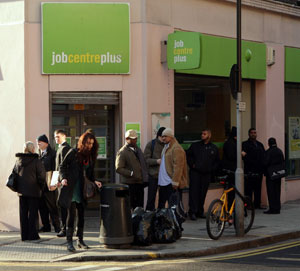Unemployment falls but claimant figures up
Unemployment falls to 2.46 million in the first three months of 2011, down 36,000, but the number of people on Jobseeker’s Allowance rises as women claimants hit a 14-year high.

The latest job figures show that 2.46 million people were out of work across the country during the first quarter of the year.
The Office for National Statistics revealed the unemployment rate was now 7.7 per cent of the workforce, down by 0.1 per cent on the previous quarter.
The number of unemployed men fell by 31,000 to 1.43 million, while the number of unemployed women fell by 5,000 to 1.03 million.
But the number of people claiming Jobseeker’s Allowance rose by 12 400 to 1.47m in April, the largest increase in 15 months. Economists were expecting a decline of between 4,000 and 10,000.
Half of the increase was due to female claimants switching from lone parent income support to Jobseeker’s Allowance because of benefit changes.
The number of unemployed 16 to 24-year-olds fell by 30,000 to 935,000, or 20 per cent of the economically active population in that age group.
Read more: Unemployment hits women hardest
Employment Minister Chris Grayling said the figures represented a “step in the right direction”, but he warned that the number of people claiming Jobseeker’s Allowance was likely to continue to rise
Shadow Work and Pensions Secretary Liam Byrne said the Government must do more to get people back to work and questioned why unemployment was falling “much faster” in other developed economies, particularly Germany and the US.
Average earnings, including bonuses, rose by 2.3 per cent in the three months to March, compared with 2.1 per cent for the quarter to February.
“Wage pressures have remained modest, reinforcing the case against an early increase in interest rates,” said David Kern, chief economist at the British Chambers of Commerce.
Despite trade union opposition to Government cuts, the ONS said that the number of working days lost through labour disputes in the year to March was the joint lowest total since records began in 1930.
TUC general secretary Brendan Barber said today’s figures were positive for those looking for work but warned new jobs were not being shared evenly across he country.
He said: “Merthyr Tydfil is now the hardest place in Britain to find a job, followed by the Scottish industrial heartlands and inner London, where over 20 dole claimants are chasing every vacancy.
“With spending cuts just starting to take effect and expected to lead to heavy job losses later this year, we are still concerned that the good news may not last for much longer.”
North-east England had the highest unemployment rate, up 0.3 points on the quarter at 10.4 per cent, followed by the West Midlands, down 0.2 points at 9.5 per cent. The lowest rate was in south-east England, down 0.4 points at 5.7 per cent.
The 7.7 per cent unemployment rate compares with 9.9 per cent in the eurozone, 9 per cent in the US and 4.6 per cent in Japan.